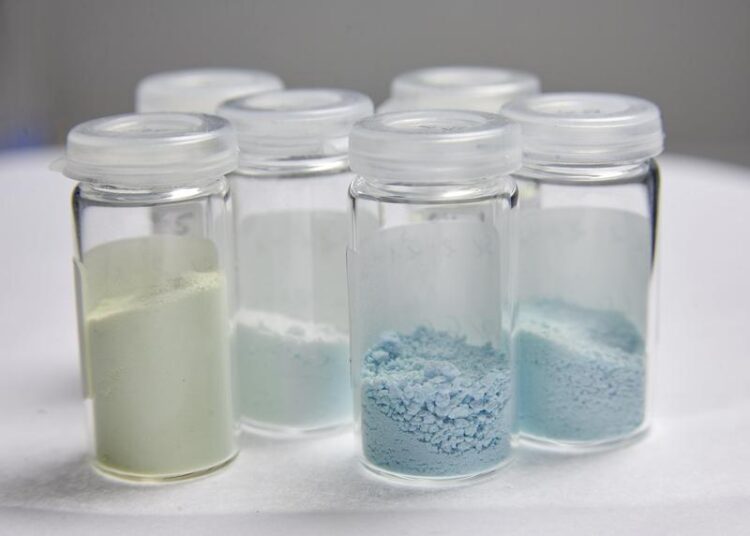For shorter approval times

Jars with compounds in the laboratory (Symbolic picture)
Credit: LIKAT/Nordlicht
New process simulates decomposition of too long stored drugs in 15 minutes.
Before their approval, pharmaceuticals not only have to be tested for their effectiveness and safety, but also for their stability, since they are usually stored in pharmacies and private households for years and are not allowed to change. To test their stability, a process is needed that decomposes the drug “in fast motion”.
Such a method was recently developed by a team of scientists from the Leibniz Institute for Catalysis in Rostock (LIKAT), the RWTH Aachen University and the Julius Maximilian University of Würzburg, accompanied by the company RD&C (Vienna, Austria). The research results have now been published in the journal ACS Central Science.
Virtually all drugs are multicomponent or multiphase systems that are embedded in a matrix, i.e. contain excipients and carriers, for example. These additives can interact with the active ingredient over time, for example when the drugs are stored for a longer period of time and impair the effect of the drug. The pharmaceutical industry must disclose all stability data before a new drug is approved, so there is considerable interest in developing reliable predictive tools to assess the safety of drugs.
Currently, however, such predictive tools for solid-state properties, particularly with respect to solid-state stability and degradation, are limited. In addition, the rate and decomposition products of solid-state degradation processes are unique for each compound, making the development of stability models very time-consuming and costly. Prediction methods in aqueous environments exist, but they lead to high error rates. Since irrelevant degradation products are often formed under these conditions, these prediction methods imply a high financial and health development risk for the manufacturer of new drugs and for the customer.
Based on proof-of-concept studies successfully performed by RD&C and the team, a unique and innovative experimental method for predicting stability profiles and degradation pathways in solid compounds, mixtures and matrices has now been developed. In the literature, the approach is referred to as mechanochemistry. In this approach, the isolated drug or marketed pharmaceutical product is treated in a vibrating mill in the presence of a decomposition-inducing reagent. Within less than 15 minutes, degradation processes can be observed.
Everaldo Krake (LIKAT Rostock), first author of the study and a newly graduated young scientist, explains: “We were able to show this on a series of structurally similar so-called thienopyridines, which are the drugs in antiplatelet tablets. Crucial to the success was the collaboration with the group led by Carsten Bolm (RWTH Aachen University), a world-leading expert in the field of mechanochemistry, and the team of Ulrike Holzgrabe (University of Würzburg), a renowned pharmaceutical chemist”
This showed that the degradation profiles are identical for both the pure drug and the finished pharmaceutical product. This means that reproducible and relevant statements can be made for this class of drugs in short reaction times using the active ingredient alone. This would be of great importance for accelerated drug approval.
According to the authors, this new approach represents a paradigm shift in the application of mechanochemical processes in organic chemistry. “In general, mechanochemical studies of the transformation of small organic molecules, particularly drugs, are carried out with the aim of producing specific structural motifs. The new work now published highlights the potential of this approach to also target specific structural motifs for degradation,” says Carsten Bolm. This could be important not only for drug testing, but also for organic synthesis in general. “In the future, it will be interesting to apply this mechanochemical approach to other drug families and to evaluate the role of other stimuli such as light or temperature for the forced degradation process,” Ulrike Holzgrabe concludes.
Wissenschaftliche Ansprechpartner:
Prof. Torsten Beweries, Leibniz-Institut für Katalyse e.V., Albert-Einstein-Str. 29a, 18059 Rostock, Germany. Email: torsten.beweries@catalysis.de
Prof. Carsten Bolm, RWTH Aachen University, Institut für Organische Chemie, Landoltweg 1, 52074 Aachen, Germany. Email: carsten.Bolm@oc.rwth-aachen.de
Prof. Ulrike Holzgrabe: Universität Würzburg, Institut für Pharmazie und Lebensmittelchemie, Am Hubland, 97074 Würzburg, Germany. Email: ulrike.holzgrabe@uni-wuerzburg.de
Originalpublikation:
E. F. Krake, L. Backer, B. Andres, W. Baumann, N. Handler, H. Buschmann, U. Holzgrabe, C. Bolm, T. Beweries, ACS Cent. Sci. 2023, DOI: 10.1021/acscentsci.3c00167.
Media Contact
All latest news from the category: Life Sciences and Chemistry
Articles and reports from the Life Sciences and chemistry area deal with applied and basic research into modern biology, chemistry and human medicine.
Valuable information can be found on a range of life sciences fields including bacteriology, biochemistry, bionics, bioinformatics, biophysics, biotechnology, genetics, geobotany, human biology, marine biology, microbiology, molecular biology, cellular biology, zoology, bioinorganic chemistry, microchemistry and environmental chemistry.
Newest articles
Faster, more energy-efficient way to manufacture an industrially important chemical
Zirconium combined with silicon nitride enhances the conversion of propane — present in natural gas — needed to create in-demand plastic, polypropylene. Polypropylene is a common type of plastic found…

Energy planning in Ghana as a role model for the world
Improving the resilience of energy systems in the Global South. What criteria should we use to better plan for resilient energy systems? How do socio-economic, technical and climate change related…

Artificial blood vessels could improve heart bypass outcomes
Artificial blood vessels could improve heart bypass outcomes. 3D-printed blood vessels, which closely mimic the properties of human veins, could transform the treatment of cardiovascular diseases. Strong, flexible, gel-like tubes…




















